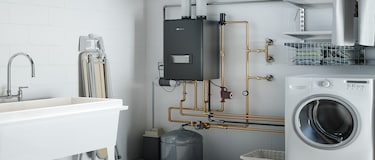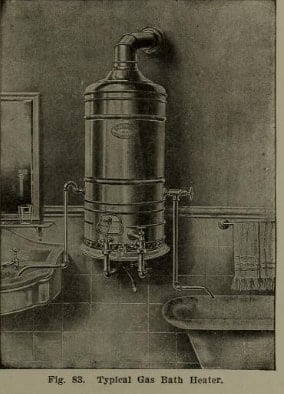
Water Heaters 101
How Hot Water Heaters Work
Imagine life without hot water.
Freezing-cold showers. Dishes and clothes that won’t come clean. If you want hot water, you would need to boil it on the stove like your great-great-grandparents used to do.
Most people realize the importance of hot water only when their water heater fails, which is why many settle for the first replacement offered by the repair service.
That’s why it’s important to understand how hot water heaters work and what options you have, so you know what you need before you need it.
Hot Water Heater Basics

There have been many takes on this concept throughout history. Early water heaters used a coal- or wood-fired stove to heat water, which would then be emptied into a tank for use in bathing or clothes washing. In some cases, match-lit gas burners accomplished the same task.
Water Heater Types
Around the turn of the 20th century, automatic water heaters began to enter the marketplace for the first time and allowed people to have hot water for their entire home when they needed it.
Two types of automatic water heating developed: Storage and tankless.
Storage Water Heaters
A storage tank water heater works differently depending on its fuel source.
Gas-Powered
Natural gas, oil-fired, and propane tank water heaters use their fuel to run a burner which ignites when the heater’s thermostat indicates that the water inside the tank has fallen below the set temperature. Typically, the water heater temperature is set between 110°-140°F.
Cold water enters from the top of the tank and goes through a dip tube reaching to the bottom of the tank, where the burner heats it. As the water is heated, it begins to rise back toward the top of the tank until it reaches the hot water outlet and exits the heater to travel to the fixture.
The combustion gases created by the burner vent through a flue running down the center of the storage tank. The flue doubles as an effective heat conductor, since its baffled design slows the movement of the hot gases through the heater.
Electric-Powered
When it comes to electric water heaters, current runs through a 220-volt circuit and past two heating elements powered by a thermostat that senses when the water has fallen below the set temperature.
The principles behind an electric hot water heater are the same ones that operate an electric coffee maker. Electrical energy is converted into heat energy inside the heating elements and transfers, via conduction, into the stored water.
While both gas and electric storage tank water heaters must be excellent heat conductors internally, they must also prevent heat from quickly escaping outside. Otherwise, efficiency would plummet, and lukewarm water would become the norm. For this reason, the tanks are heavily insulated with a resistive material, such as polyurethane foam, to retain the heat as long as possible.
Tankless Water Heaters
Tankless hot water heaters, also known as "on-demand water heaters," do not store hot water. Instead, they use a heat exchanger to heat the water.
As with storage tank units, tankless water heaters come in electric, natural gas, and propane models.
When a user opens a hot water tap, cold water enters the heater typically from the bottom, (although top-mount models are now available for easier replacement of tank units). At this point, the flow sensor detects the incoming water, and a circuit board activates a gas- or electric-powered heat exchanger, which heats the cold water passing through it.
A tankless unit will continue heating water as long as the tap is turned on. Once the flow sensor detects that the tap has closed, the unit will stop heating. In a gas-powered unit, a blower drives exhaust gases out the exhaust pipe.
To eliminate having to wait for hot water, some tankless water heaters come with an internal recirculation pump, which can work with a recirculation line to provide instant hot water to distant fixtures. Essentially, the pump pushes warm water through a building’s plumbing lines on a schedule or after a motion- or touch-activated sensor is triggered at the fixture.
Other types of tankless water heaters use condensing technology. These higher efficiency units incorporate a secondary heat exchanger to capture heat from outgoing exhaust gases and preheat incoming cold water, thereby avoiding wasted energy and saving you money.
Alternative Water Heating Options
Besides storage and tankless water heaters, the other options are indirect, point-of-use (POU), and heat pump.
POU heaters are typically installed in commercial or large residential applications with distant hot water fixtures or next to hot tubs and other appliances that would otherwise tax a central water heating system.
Many modern heat pump water heaters come in hybrid configurations. These units include backup electric heating elements that kick on during the coldest days when the water heater can't extract enough heat from the surrounding air. Learn more about the benefits of heat pump water heaters.
No Hot Water? No Problem
Often, when people choose a new refrigerator or washing machine, they search for the best features and deals money can buy. With water heaters, just getting the hot water flowing again becomes the priority. There simply isn't time for heavy research.
But now that you understand the basics of water heaters, you will be better equipped to pick the best product for your application.
Water Heater Buyer's Guide Navigation
Home | Tank Water Heaters | Tankless Water Heaters | Point-of-Use Water Heaters | Indirect Water Heaters


